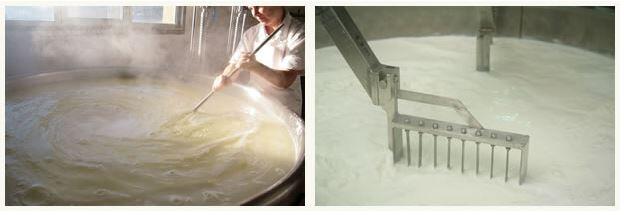The Val D’Orcia (Valley of Orcia) South of Sienna is the absolute epitome of what we all expect Tuscany to look like … a landscape of green valleys surrounded by rolling hills and a horizon punctuated by rows of lonely cypress trees. You really should take the time to visit this beautiful area of Tuscany and get to experience some of its’ wonderful artisan foods and wines at their source. The area is best known for the wonderful Pecorino di Pienza, made exclusively in and around the town of Pienza which is situated close to the wine producing towns of Montalcino and Montepulciano, home to the Tuscan classic wines.

What is Pecorino di Pienza Cheese?
Pecorino, famous all over the world, is named for the milk used to create it…Pecora is Italian for a ewe, and this cheese is made exclusively from whole, raw ewe’s milk. Pecorino is made all over Italy, but the Pecorino from Pienza is unique and special; the sheep who supply the milk are a tough breed, mostly the Sarda, originally from Sardinia, and are well adapted to the terrain of the area which is not suitable for crop farming, but wonderful for sheep! They feed exclusively on the indigenous vegetation of the area, a mixture of grasses and wild herbs including wormwood, meadow salsify, broom, juniper and burnet and it is this diet which makes the cheese special, as traces of herb can be detected in the cheese. It is a seasonal cheese, made only during the Summer when the milk quality is at its’ best, so you will only find young Pecorino in Summer; the mature cheese can, however, be enjoyed all year around.

To a certain extent the cheese has become mass-produced; demand has exceeded supply and has led to milk from other areas being “imported”, resulting in a change of the original character of the cheese. However, there are still at least two family-run Pecorino makers near Pienza where the cheese is still produced organically in the age-old way, and these are the two you should try and visit: Podere Il Casale and Cugisi.
Pecorino di Pienza Cheese tour at the local dairy.
The raw milk is mixed with rennet to curdle it. The curds sink to the bottom of the container and are scooped out to dry before being placed in a salt solution. The set cheese is then formed into “heads” or rounds. These are then wrapped in walnut leaves and placed in a cool humid cellar to mature. The rinds are periodically dampened with olive oil (Tuscan, of course!) and then grease and wax. At the moment there is no discipline in the production nor there is a PDO in place so production might vary from producer to producer. The only traditional pecorino is the one aged in wooden barriques.

Eating Pecorino di Pienza.
Pecorino is eaten either as a soft cheese after about 40 – 60 days’ maturation, or left in the cellar for up to 15 months (5 – 12 months is the average). When young,(Pecorino Fresco), you can expect the cheese to be soft and creamy, with a spicy undertone and the herby diet of the sheep really comes to the fore. The rind will be a creamy colour.
A more mature Pecorino will have a darker rind, generally red or black, and the texture is soft and crumbly on the palate with a slightly tannic after-taste; at this point the spicy tones are no longer evident. It is generally believed that Pecorino does improve with ageing, as it acquires more character and structure.
In Tuscany, the cheese is not often used in combination with other foods or used for cooking, but rather enjoyed in its’ own right. The Fresco (young Pecorino) is eaten with a light touch of great Tuscan olive oil or a little of the regions’ chestnut honey. It is sometimes served with sliced pears or raw fava beans and prosciutto as a lovely simply anti-pasti. The matured cheese, (Stagionato) is great to grate! Serve it over a wonderful pasta or risotto, or in thin slices with Proscuitto and other cured meats..
Of course, you need a really lovely wine from the region to complete the feast; the Rosso di Montalcino is just the perfect match. This is a young, unmatured Sangiovese, (only up to a year in the cask) and “baby brother” to the famous Brunello di Montecino, for which the region is famous. Another good wine from the region to try with the cheese is Rosso di Montepulciano; this is also a young, fresh tasting wine comprised of mainly Sangiovese grapes. If you love dessert wines try the Moscadello di Montalcino, a fine late-harvested Muscat which makes the most perfect simple ending to a great Tuscan meal; serve it with fresh seasonal fruit, local honey and some Pecorino Fresco. A perfect way to savoir the essence of the Val D’Orcia!
Emilia Delizia food tours in Tuscany.
If you are set to discover Italian foods, our company would be delighted to organise a cheese tour departing from Siena or Florence and go the Val D’Orcia to experience the production of Pecorino and Tuscan wines.
Submit your review | |
This company organised a great tour to a local dairy, we departed from Siena and visit the pecorino production, and a montalcino winery. Excellent experience.
Upptäck mer från Emilia Delizia
Prenumerera för att få de senaste inläggen skickade till din e-post.
Kommentarer är stängda.